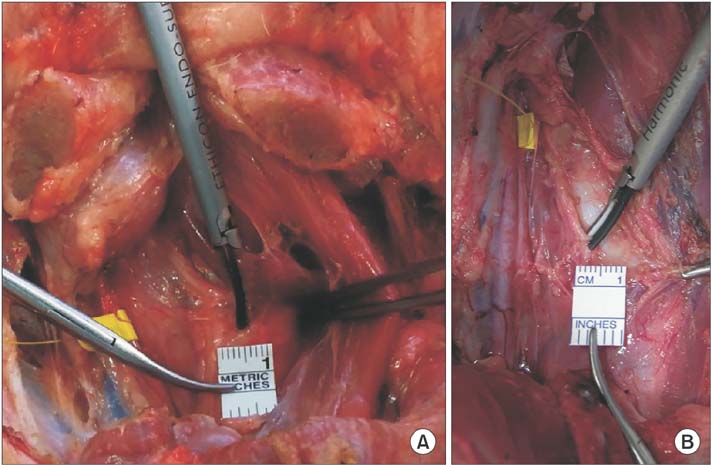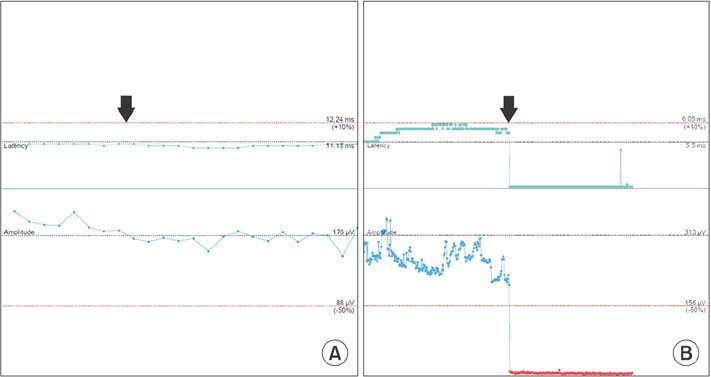Ann Surg Treat Res.
2018 Jun;94(6):285-290. 10.4174/astr.2018.94.6.285.
Comparing the safety of harmonic ACE and ACE+ around the recurrent laryngeal nerve in swine models
- Affiliations
-
- 1Department of Surgery, KUMC Thyroid Center, Korea University Hospital, Korea University College of Medicine, Seoul, Korea. hoonyubkim@korea.ac.kr
- 2Department of Surgery, Seoul Metropolitan Government - Seoul National University Boramae Medical Center, Seoul, Korea.
- 3Division for Endocrine Surgery, Department of Human Pathology in Adulthood and Childhood “G. Barresi,†University Hospital G. Martino, University of Messina, Messina, Italy.
- KMID: 2412397
- DOI: http://doi.org/10.4174/astr.2018.94.6.285
Abstract
- PURPOSE
Among the various energy-based devices, ultrasonic shears are popular in thyroid surgeries. In this study, we tested the safety of Harmonic ACE and Harmonic ACE+ around the recurrent laryngeal nerve (RLN) in experimental swine models.
METHODS
Harmonic ACE and Harmonic ACE+ were each tested in 4 piglets. Harmonic ACE and Harmonic ACE+ were activated at a 0- to 5-mm distance from the RLN. The function of the RLN was assessed using continuous electrophysiological monitoring.
RESULTS
For Harmonic ACE, there was no adverse EMG event found when activated at 4- and 5-mm distances from the RLN. At a 2- to 3-mm distance, there were 4 adverse EMG events observed. In these 4 cases, adjacent tissue shrinkage occurred after 6 to 15 seconds of activation, and the RLN touched the Harmonic ACE. At a 1-mm distance, there were 2 adverse EMG events found after 25 seconds of activation. For Harmonic ACE+, there was no adverse EMG event observed when activated at 1- and 3-mm distances from the RLN. At a 0-mm distance, 2 adverse EMG events occurred after 6 to 10 seconds of activation.
CONCLUSION
The safe distance of Harmonic ACE and ACE+ was 4 and 1 mm, respectively, in the swine models. Harmonic ACE+ is safer than Harmonic ACE because it did not cause any tissue shrinkage. Surgeons need to understand the characteristics of devices for safe operation.
Keyword
Figure
Reference
-
1. Agcaoglu O, Aliyev S, Mitchell J, Milas M, Siperstein A, Berber E. The use of the harmonic scalpel versus knot tying for modified radical neck dissection. Surg Innov. 2013; 20:81–85.
Article2. Cannizzaro MA, Lo Bianco S, Borzi L, Cavallaro A, Buffone A. The use of FOCUS Harmonic scalpel compared to conventional haemostasis (knot and tie ligation) for thyroid surgery: a prospective randomized study. Springerplus. 2014; 3:639.
Article3. Duan YF, Xue W, Zhu F, Sun DL. FOCUS harmonic scalpel compared to conventional hemostasis in open total thyroidectomy - a prospective randomized study. J Otolaryngol Head Neck Surg. 2013; 42:62.
Article4. Ferri E, Armato E, Spinato G, Spinato R. Focus harmonic scalpel compared to conventional haemostasis in open total thyroidectomy: a prospective randomized trial. Int J Otolaryngol. 2011; 2011:357195.
Article5. Melck AL, Wiseman SM. Harmonic scalpel compared to conventional hemostasis in thyroid surgery: a meta-analysis of randomized clinical trials. Int J Surg Oncol. 2010; 2010:396079.
Article6. Papavramidis TS, Sapalidis K, Michalopoulos N, Triantafillopoulou K, Gkoutzamanis G, Kesisoglou I, et al. UltraCision harmonic scalpel versus clamp-and-tie total thyroidectomy: a clinical trial. Head Neck. 2010; 32:723–727.
Article7. Yener O, Demir M, Yılmaz A, Yıgıtbaş R, Atak T. Harmonic scalpel compared to conventional hemostasis in thyroid surgery. Indian J Surg. 2014; 76:66–69.
Article8. Lang BH, Ng SH, Lau LL, Cowling BJ, Wong KP. A systematic review and meta-analysis comparing the efficacy and surgical outcomes of total thyroidectomy between harmonic scalpel versus ligasure. Ann Surg Oncol. 2013; 20:1918–1926.
Article9. Dionigi G. Energy based devices and recurrent laryngeal nerve injury: the need for safer instruments. Langenbecks Arch Surg. 2009; 394:579–580.
Article10. Cordon C, Fajardo R, Ramirez J, Herrera MF. A randomized, prospective, parallel group study comparing the Harmonic Scalpel to electrocautery in thyroidectomy. Surgery. 2005; 137:337–341.
Article11. Miccoli P, Materazzi G, Miccoli M, Frustaci G, Fosso A, Berti P. Evaluation of a new ultrasonic device in thyroid surgery: comparative randomized study. Am J Surg. 2010; 199:736–740.
Article12. Sista F, Abruzzese V, Schietroma M, Cecilia EM, Mattei A, Amicucci G. New harmonic scalpel versus conventional hemostasis in right colon surgery: a prospective randomized controlled clinical trial. Dig Surg. 2013; 30:355–361.
Article13. Mannelli G, Meccariello G, Deganello A, Maio V, Massi D, Gallo O. Impact of low-thermal-injury devices on margin status in laryngeal cancer. An experimental ex vivo study. Oral Oncol. 2014; 50:32–39.
Article14. Sinha UK, Gallagher LA. Effects of steel scalpel, ultrasonic scalpel, CO2 laser, and monopolar and bipolar electrosurgery on wound healing in guinea pig oral mucosa. Laryngoscope. 2003; 113:228–236.
Article15. Timm RW, Asher RM, Tellio KR, Welling AL, Clymer JW, Amaral JF. Sealing vessels up to 7 mm in diameter solely with ultrasonic technology. Med Devices (Auckl). 2014; 7:263–271.16. Broughton D, Welling AL, Monroe EH, Pirozzi K, Schulte JB, Clymer JW. Tissue effects in vessel sealing and transection from an ultrasonic device with more intelligent control of energy delivery. Med Devices (Auckl). 2013; 6:151–154.17. Lee KE, Jee HG, Kim HY, Park WS, Park SH, Youn YK. Development of a canine model for recurrent laryngeal injury by harmonic scalpel. Lab Anim Res. 2012; 28:223–228.
Article18. Phillips CK, Hruby GW, Durak E, Lehman DS, Humphrey PA, Mansukhani MM, et al. Tissue response to surgical energy devices. Urology. 2008; 71:744–748.
Article19. Wu CW, Chai YJ, Dionigi G, Chiang FY, Liu X, Sun H, et al. Recurrent laryngeal nerve safety parameters of the Harmonic Focus during thyroid surgery: Porcine model using continuous monitoring. Laryngoscope. 2015; 125:2838–2845.
Article
- Full Text Links
- Actions
-
Cited
- CITED
-
- Close
- Share
- Similar articles
-
- Development of a canine model for recurrent laryngeal injury by harmonic scalpel
- The method of using robotic Harmonic ACE curved shears for parenchymal transection in robotic hepatectomy
- Angiotensin Converting Enzyme (ACE) in Serum and Bronchoalveolar Lavage (BAL) Fluid in Patients with Active Pulmonary Tuberculosis
- A Study on Angiotensin Converting Enzyne Activity in Pulmonary Tuberculosis
- Concurrent Ipsilateral Recurrent and Nonrecurrent Laryngeal Nerve During Thyroidectomy: A Case Report



